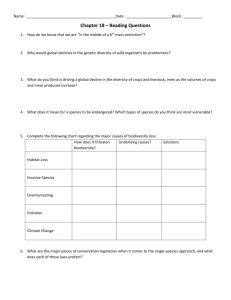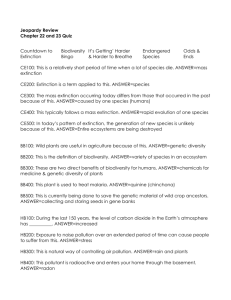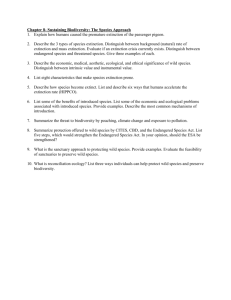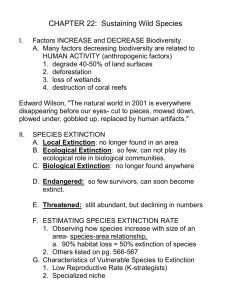Sustaining Biodiversity: The Species Approach
advertisement
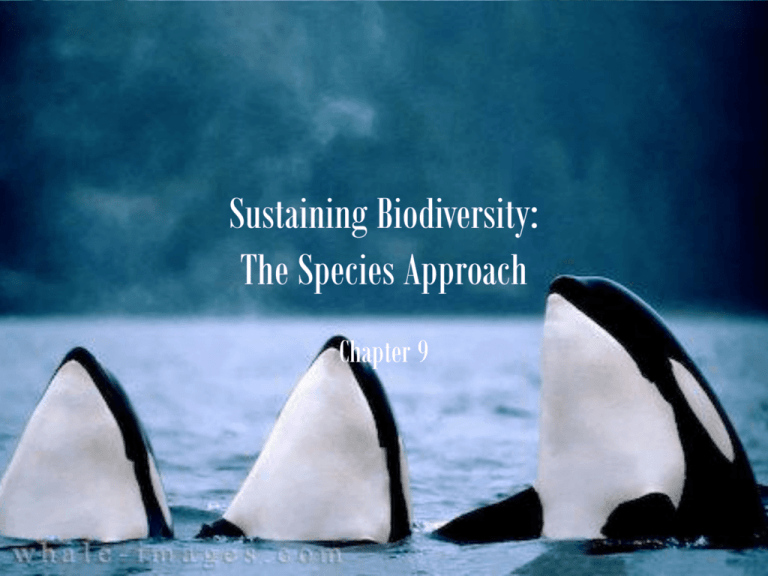
Sustaining Biodiversity: The Species Approach Chapter 9 Core Case Study: Declining Bird Species (1) • Decline of 70% of 9,775 known species • Birds around humans benefited, but forest species declined • Long-distance migrants – greatest decline Core Case Study: Declining Bird Species (2) • Reasons – Climate change – Habitat loss – Fragmentation • Birds environmental indicators • Perform economic and ecological services Threatened U.S. Songbirds 9-1 What Role Do Humans Play in the Premature Extinction of Species? • Concept 9-1 The current rate of species extinction is at least 100 times the rate that existed before modern humans arrived on earth, and is expected to increase to between 1,000 and 10,000 times the earlier rate during this century. Three Types of Extinction • Local extinction • Ecological extinction • Biological extinction Ecological Smoke Alarms • Endangered species • Threatened species • The first to go large, slow, tasty, or have valuable parts • Some behaviors make species prone to extinction Species Prematurely Extinct Calculating Extinction Rates • Extinction takes a long time, difficult to document • Only identified 1.8 million species – most unknown • Know little of ecological role of most species • Average species survive 1–10 million years • Species-area relationship Endangered or Threatened Species (1) Endangered or Threatened Species (2) California Condor - Gymnogyps californianus Largest North American bird, largest RECOVERY wingspan – Opposed by farmers who – Heavy bird Vulture => scavenger Live to 50yrs, sexually mature at 6 – Lay only one egg at a time, every other year • Top of food chain • Causes of endangerment: – Poaching (farmers incorrectly assumed they had killed their livestock, museums) – Lead poisoning (eating lead shot in carcasses) – DDT poisoning – Habitat destruction (gold mining) maintained misconception – Opposed by those who felt birds had a right to freedom • Captive breeding in San Diego and Los Angeles after all 22 wild birds caught (’87) – Most expensive program ever • Released birds killed by lead and power lines – Captives trained to avoid lines – Ridley-Tree Condor Preservation Act requires non-lead bullets in range – As of April 2009, 322 individuals including 172 wild Human Activities and Extinction • Background extinction rate • Current rate is 100 times background extinction • Rate likely to rise 1,000–10,000 times with climate change • Is a mass extinction coming? Characteristics of Species Prone to Extinction Percentage of Various Taxa Endangered Current Extinction Rate Estimates Are Conservative • Species and biodiversity decrease in next 50–100 years • Biodiversity hotspot rates higher than global average • Degrading, simplifying, and destroying diverse environments 9-2 Why Should We Care about Preventing Species Extinction? • Concept 9-2 We should prevent the premature extinction of wild species because of the economic and ecological services they provide and because they have a right to exist regardless of their usefulness to us. Value of Species • Instrumental value of biodiversity – Food crops – Genetic information – Medicine • Do not know what we lose when species go extinct Nature’s Pharmacy Values of Species Diversity • Recreational pleasure value • Eco-tourism >$500 billion per year • Ethical obligations – intrinsic (existence) value • Foundation of earth’s ecosystems bacteria and other microorganisms 9-3 How Do Humans Accelerate Species Extinction? • Concept 9-3 The greatest threats to any species are (in order) loss or degradation of its habitat, harmful invasive species, human population growth, pollution, climate change, and overexploitation. Underlying and Direct Causes of Depletion Fig. 9-7, p. 183 Secondary Causes of Endangerment and Premature Extinction (HIPPCO) • Habitat destruction • Invasive species • Population growth • Pollution • Climate change • Overexploitation Habitat Loss • Deforestation of tropical areas greatest eliminator of species • Endemic species • Habitat fragmentation Range Reductions in Four Species Species Introductions • Most beneficial – food crops, livestock, pest control • 500,000 alien invader species globally • 50,000 nonnative species in the U.S. Deliberately Introduced Species Accidentally Introduced Species Case Study: The Kudzu Vine • Kudzu introduced to control erosion • Prolific growth • Uses – Asians use powdered starch in beverages – Source of tree-free paper – Japanese kudzu farm in Alabama Invasive Kudzu Vine Fig. 9-10, p. 186 Disruptions from Accidentally Introduced Species • Downside of global trade • Argentina fire ant • Burmese python Argentina Fire Ant Fig. 9-11, p. 186 Prevention of Nonnative Species (1) • Identify characteristics of successful invaders • Detect and monitor invasions • Inspect imported goods • Identify harmful invasive species and ban transfer Prevention of Nonnative Species (2) • ships discharge ballast waters at sea • introduce natural control organisms of invaders Characteristics of Successful Invaders Fig. 9-12, p. 187 What Can You Do? Fig. 9-13, p. 188 Human Choices Drive Extinction • Human population growth • Excessive, wasteful consumption • Use of pesticides DDT and Bioaccumulation • 1950s–1960s fish-eating bird populations drop • DDT biologically magnified in food webs • Bird’s eggshells thin and fragile • Leads to unsuccessful reproduction Bioaccumulation of DDT Fig. 9-14, p. 188 Recovery • Bald eagle recovered • Factors leading to recovery – Ban on DDT – Crackdown on hunting – Prevention of habitat destruction Climate Change and Extinction • More rapid compared to the past • Expected to eliminate >25% of land animal and plant species • Polar bears and penguins threatened Illegal Killing and Trading of Wildlife • Poaching endangers many larger animals, rare plants • Over two-thirds die in transit • Illegal trade $6–$10 billion per year • Wild species depleted by pet trade • Exotic plants often illegally gathered White Rhinoceros Poached for Its Horn Fig. 9-15, p. 189 The Value of Wild Rare Species • Declining populations increase black market values • Rare species valuable in the wild – eco-tourism • Some ex-poachers turn to eco-tourism Rising Demand for Bush Meat • Traditional use of bush meat • Demand increasing with population growth • Increased road access • Loggers, miners, ranchers add to pressure • Local and biological extinctions Bush Meat on the Rise Fig. 9-16, p. 190 9-4 How Can We Protect Wild Species from Premature Extinction? • Concept 9-4A We can use existing environmental laws and treaties and work to enact new laws designed to prevent species extinction and to protect overall biodiversity. • Concept 9-4B We can help prevent species extinction by creating and maintaining wildlife refuges, gene banks, botanical gardens, zoos, and aquariums. International Treaties • Convention on International Trade of Endangered Species (CITES) • Convention on Biological Diversity (CBD) Case Study: Controversy over the U.S. Endangered Species Act (1) • National Marine Fisheries Services – ocean species • U.S. Fish and Wildlife Service – other species • Listings based on biological factors • Forbids federal agency projects that jeopardize listed species or habitats Case Study: Controversy over the U.S. Endangered Species Act (2) • Fines violations on private land – 90% listed species on private land • Illegal to sell or buy listed species • 1,180 species listed • USFWS and NMFS supposed to prepare recovery plan – 25% species have a plan Case Study: Controversy over the U.S. Endangered Species Act (3) • Successful recovery plans include American alligator and grey wolf • Lax enforcement • Smugglers not aware of dangerous diseases in exotic species • Amended to give private landowners economic incentive to save species Case Study: Controversy over the U.S. Endangered Species Act (4) • ESA protect endangered marine reptiles and mammals • Challenges to protecting marine species – Limited knowledge of species – Difficulty in monitoring and enforcing treaties – open oceans Hawaiian Monk Seal with Plastic Debris Fig. 9-17, p. 192 Endangered Green Sea Turtle Fig. 9-18, p. 192 Opposition to Endangered Species Act • Opponents want: – Voluntary protection on private land – Government compensation for land owners – Bureaucratic obstacles to listing species – Elimination of need for critical habitat – Exemptions granted by Secretary of Interior • Steps to weaken ESA New Ecosystems Approach • Inventory country’s species and ecosystems • Locate and protect the most endangered ecosystems • Make development biodiversity-friendly through financial incentives and technical help Science Focus: Goals of the Endangered Species Act • Biologists defend limited success • Need more funding • Develop recovery plans more quickly • Core habitat established when listed Establish Wildlife Refuges • National Wildlife Refuge System • Wetland refuges • 35 million American visitors • 20% of listed species in refuge system Storing Genetic Information • Gene or seed banks • Botanical gardens • Farms – commercial sale of endangered species removes pressure Zoos and Aquariums for Protection • Collect species with long-term goal of returning them into habitat • 100–500 captive individuals to avoid extinction • 10,000 individuals to maintain capacity for biological evolution 9-5 What Is Reconciliation Ecology? • Concept 9-5 We can help protect some species from premature extinction by finding ways to share the places we dominate with them. Reconciliation Ecology • Danger that biodiversity preserve efforts will fail • Develop reconciliation ecology Case Study: The Blackfoot Challenge (1) • Blackfoot River – large Montana watershed • 600 plant and 21 large animal species • Seven human communities, 2,500 rural households • Community established Action Team Case Study: The Blackfoot Challenge (2) • Developed Restoration, sustainable grazing, conservation easement plans • Created corridor between undeveloped lands • Restored wetlands, streams Video: Penguin Rescue Videos/Penguin_Rescue.mov Video: Bachelor Pad at the Zoo Videos/Bachelor_Pad_Zoo.mov



